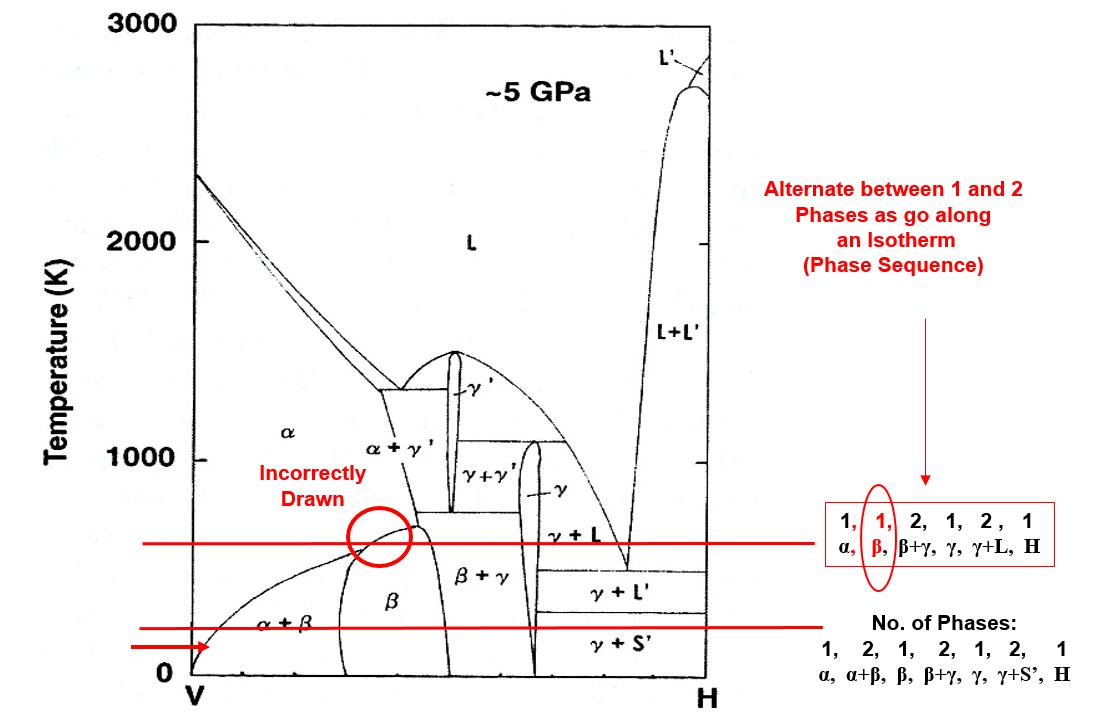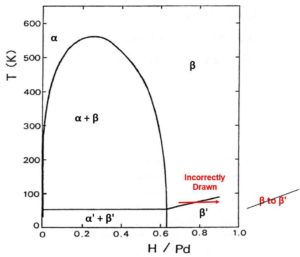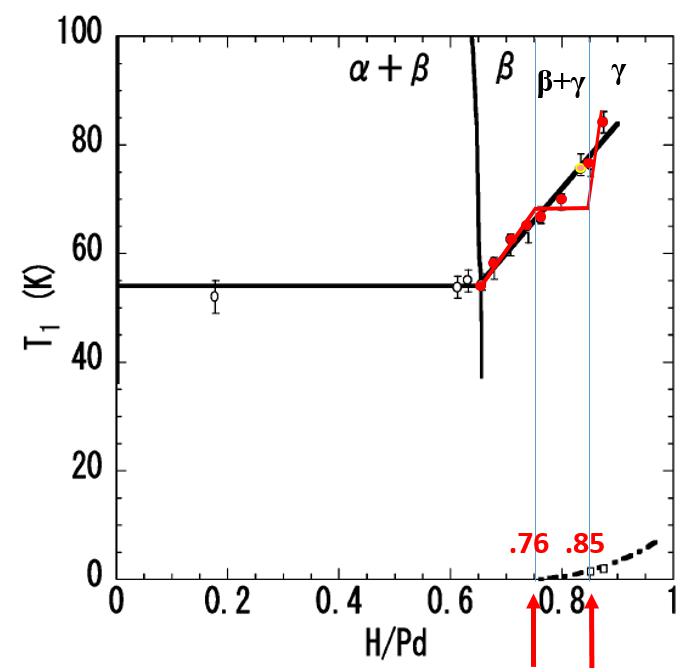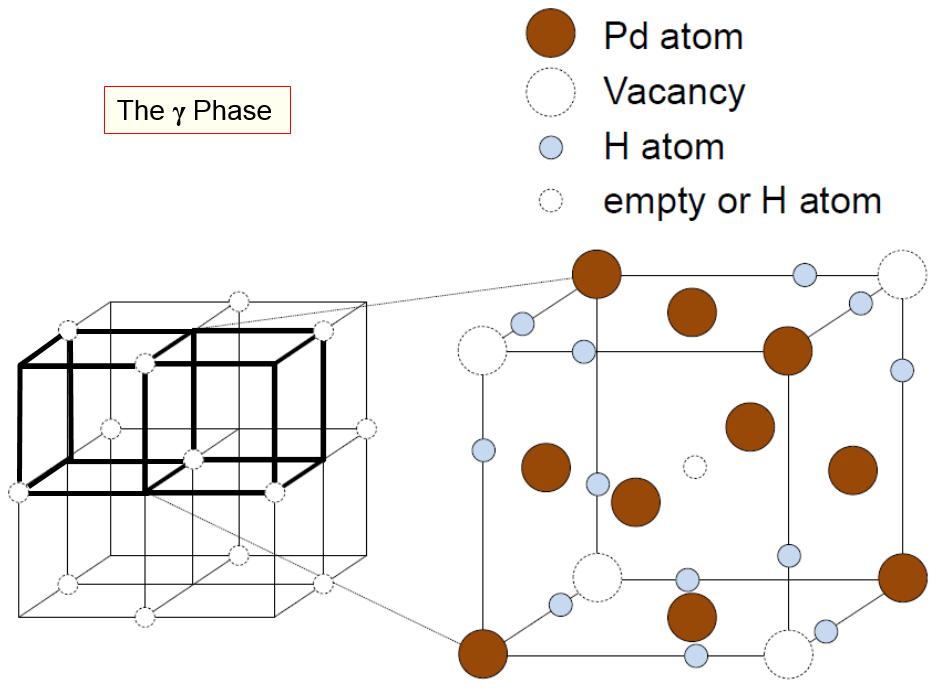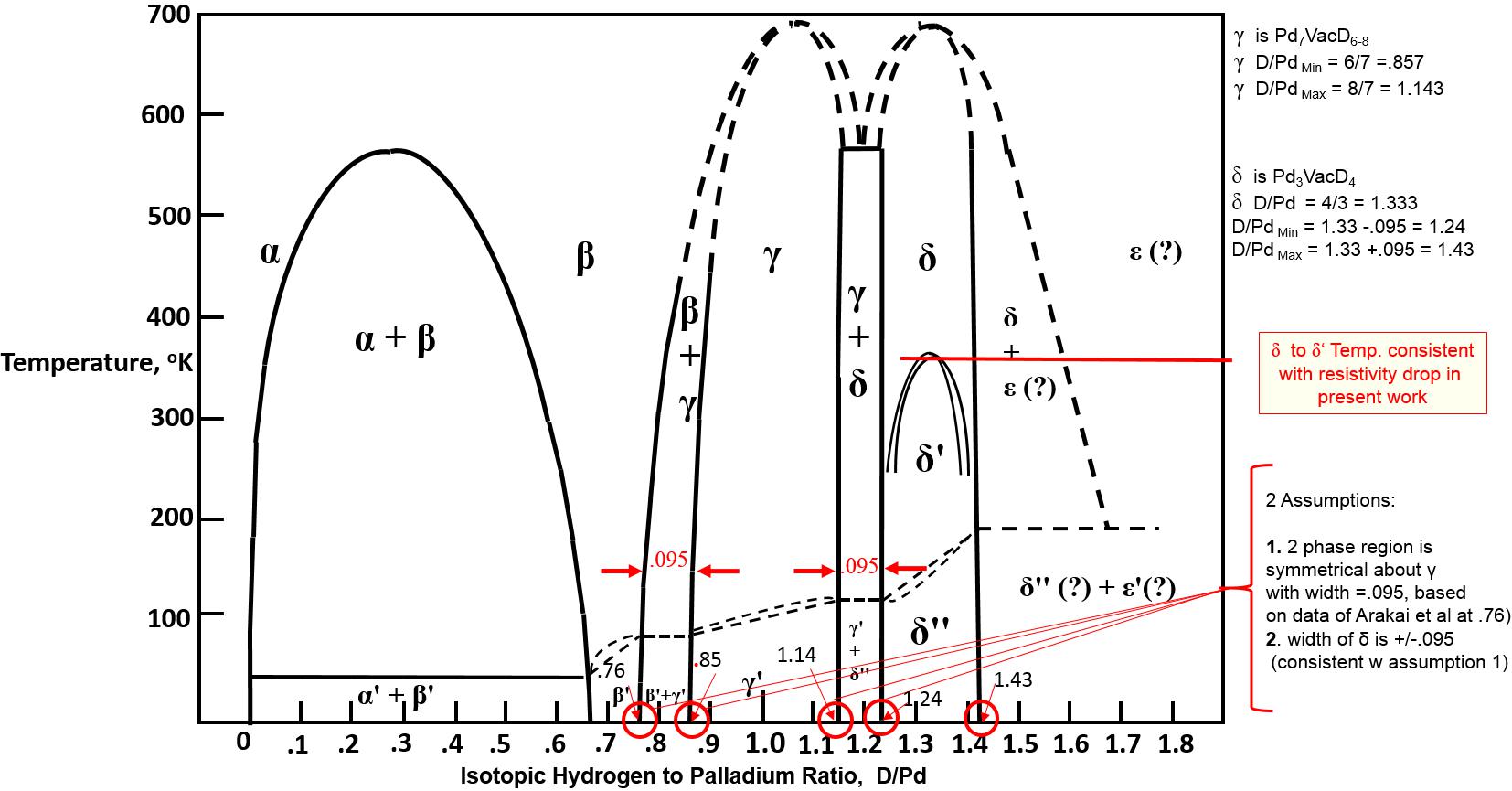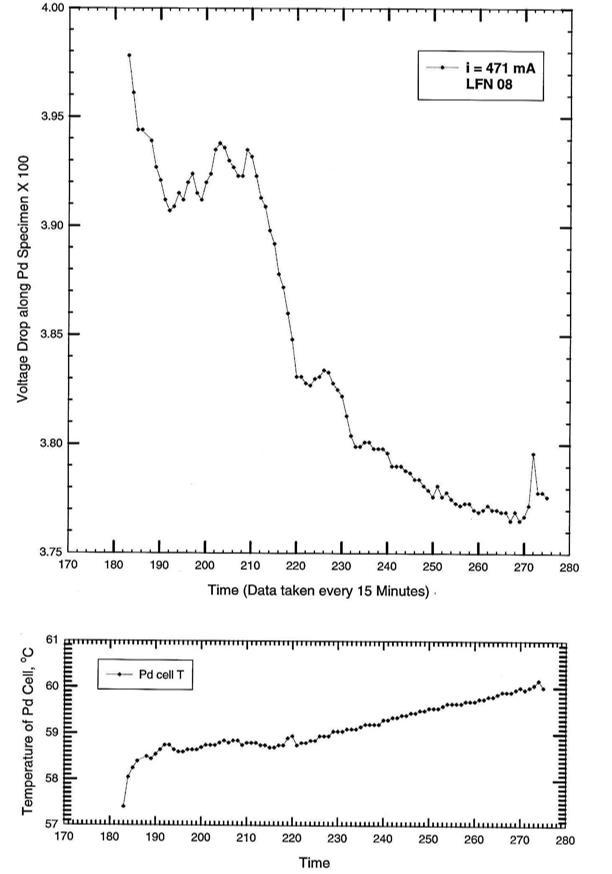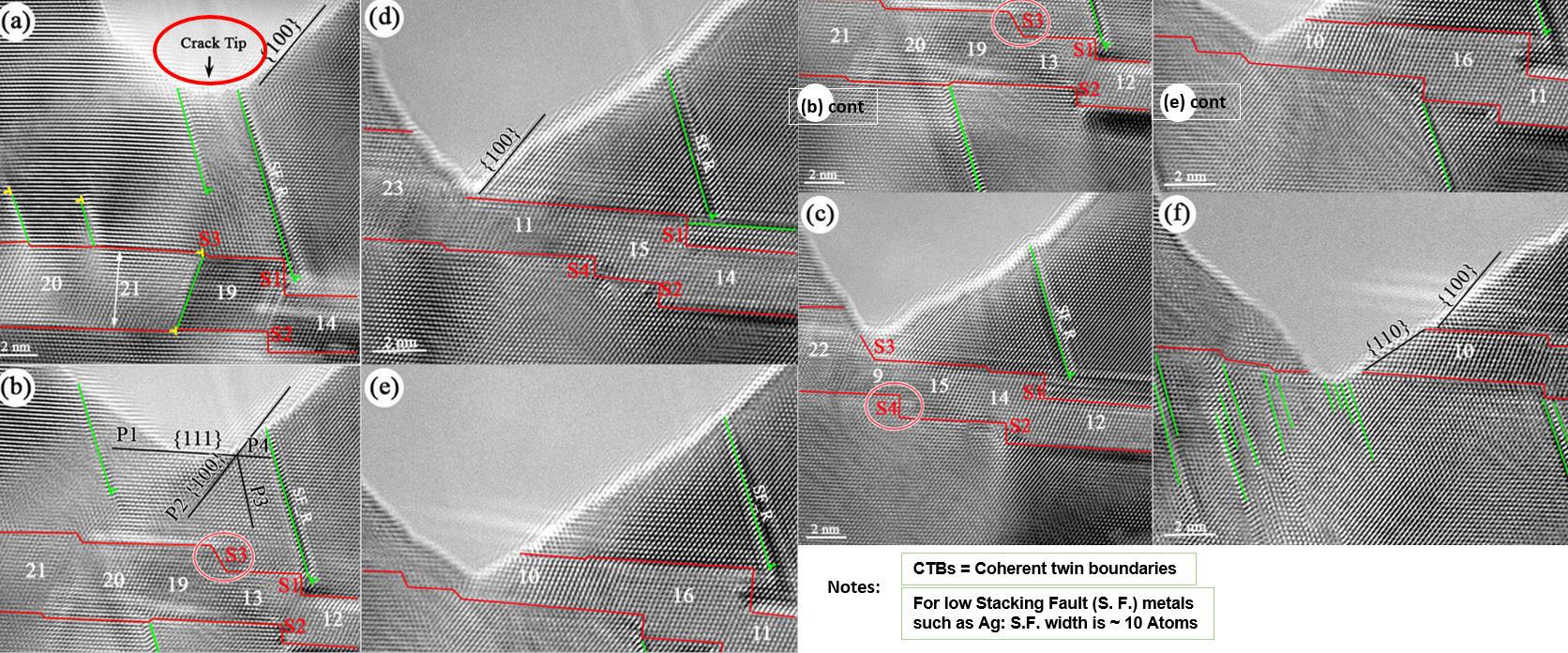This is a copy of ICCF21_Staker_2_Oct_2018 submitted to JCMNS for the ICCF-21 Proceedings. Only material particularly relevant to Superabundant Vacancies is retained here.
There is a newer version of the paper than the one I used for this study, available on lenr-canr.org.
[Coupled Calorimetry and] Resistivity Measurements, in Conjunction with an Emended and More Complete Phase Diagram of the Palladium – Isotopic Hydrogen System
Redacted abstract:
[…] High fugacity of deuterium was developed in unalloyed palladium via electrolysis (0.5 molar electrolyte of lithium deuteroxide, LiOD) with the use of an independent electromigration current. In situ resistivity measurements of Pd were used to assay activity of D in the Pd lattice (ratio of D/Pd) and employed as an indicator of phase changes. […] High fugacity was required for these results, and the triggered run-away events required even higher fugacity. […] X-ray diffraction results from the recent literature, rules for phase diagram construction, and thermodynamic stability requirements necessitate revisions of the phase diagram, with addition of three thermodynamically stable phases of the superabundant vacancy (SAV) type. These phases, each requiring high fugacity, are: γ (Pd7VacD6-8), δ (Pd3VacD4 – octahedral), δ’ (Pd3VacD4 – tetrahedral). The emended Palladium – Isotopic Hydrogen phase diagram is presented. The excess heat condition supports portions of the cathode being in the ordered δ phase (Pd3VacD4 – octahedral), while a drop in resistance of the Pd cathode during increasing temperature and excess heat production strongly indicates portions of the cathode also transformed to the ordered δ’ phase (Pd3VacD4 – tetrahedral). A dislocation mechanism is presented for creation of vacancies and mobilizing them by electromigration because of their attraction to D+ ions which aids the formation of SAV phases. Extending SAV unit cells to the periodic lattice epiphanates δ as the nuclear active state. The lattice of the decreased resistance phase, δ’, reveals extensive pathways of low resistance and a potential connection to the superconductivity phase of PdH/PdD.
Redacted body of paper:
1. Introduction
Modifications of properties in metals and alloys, apart from hydrogen embrittlement and degradation (reviewed by Robertson et al. [1]), by introducing hydrogen to high activity include: increased and decreased resistivity [2], induced ferromagnetism [3], optical property changes [4, 5], increased lattice atom mobility [6, 7], induced ordering [8, 9], increased levels of vacancies [10, 11], and even vacancies at concentrations near 25 percent [12, 13, 14, 15, 16, 17, 18, 19, 20, 21, 22], called superabundant vacancies (SAV). SAV formation in face centered cubic (FCC) metals changes the unit cells from FCC to simple cubic (SC) with vacancies (Vac) at all corner atoms of the FCC unit cell. This Vac ordering is similar to the gold (Au) ordering in copper-gold (Cu3Au). In palladium (Pd), ordered SAV structures are: Pd3Vac1Dx (δ phase) [15, 21] where x is between 4 and 8, and Pd7Vac1D6-8 (γ phase) [22]. Isotopic hydrogen atoms [protium (H), deuterium (D), or tritium (T)] occupy the octahedral interstitial sites (δ phase) singly or as a pair of closely spaced atoms in Pd3Vac1Dx [15, 21] and/or occupy tetrahedral sites (δ’ phase) [23, 24]. (Naming here follows the convention of phase diagram construction of phases left to right in order of the Greek alphabet.) SAV are observed in other metals/alloys beside Pd and nickel Ni and include: Fe, Mn, Ti, Zr, Nb, Al, Cu, Mo, Cr, Co, Ag, Au, Rh, Pt, Ir, Pu, Pd-Rh Alloys, Pd-Ag Alloys, and Cu-Ni Alloys. SAV have been produced by the following methods: wet electrolysis, high-temperature with high-pressure gas via anvil compression, co-deposited electrolysis, solid state electrolysis (dry electrolyte), ion beam implantation, and plasma-injection. Eliaz et al [25] have reviewed hydrogen-assisted processing of materials. Links between processing, structure and properties is continuously sought by metallurgists and material scientists. Does increased space between atoms along unit cell edges change conductivity, electron mobility, and redistribution of electron density (Schrodinger equation), and thereby enable nuclear reactions inside a lattice along these edges? The first purpose of this investigation is to position the new phases appropriately on the Pd-isotopic hydrogen equilibrium phase diagram. The second purpose is to investigate if electrolytically loading of D into Pd produces excess heat (more heat out than in) consistently, benefiting from electromigration and high dislocation density from plastic deformation with associated increase in vacancies. A related purpose is to explore if SAV favor nuclear reactions at high fugacity because of unusual crystallography (open tube lattice) compared to the traditional PdD unit cell (β phase with its usual electron distribution). Traditional phases of metal hydrides (α and β) might not be unusual enough in structure, and electron distribution to support nuclear reactions; but SAV phases, distinct from β phase and having open tubes and unfamiliar electron-proton (or deuteron) interaction, are insufficiently explored. Zhang and Alavi [26] have used density-function theory to show electronic structure is more important than entropy effect in forming SAV.
2. Analysis
The purposes of this section are to show: (1) these new phases, γ, δ, and δ’, are equilibrium phases, (2) near room temperature, they require creation of vacancies by a mechanism other than diffusion (dragging of jogs by moving screw dislocations) and relocation of vacancies (aided by attraction to electromigrating D+ ions), and lastly (3) apt incorporation into the Pd-isotopic hydrogen equilibrium phase diagram.
Although evidence for high vacancy content in SAV phases was originally obtained by unit cell dimensional changes [12], strongest evidence [15, 20, 21, 22, 23, 24] for these three phases, with distinct crystal structures, comes from X-ray diffraction (XRD). It is also supported by thermal decomposition spectra [15, 27, 28]. In thermal desorption data for pure Cu [27] and Ni [28], the spectra is the same for samples prepared via high-pressure/high-temperature to those created with electrodeposition (co-deposition of H(D) and Pd during electrolysis) at room temperature. In the former, the kinetics for formation is aided by high-pressure/high-temperature (high fugacity) while in the latter the structure is created atom by atom so kinetics is bypassed, evolving directly into the lowest energy state, SAV. Only with subsequent thermal activation can hydrogen be coaxed into egressing (desorbed). The kinetics and signature of desorption is the same regardless of how the SAV state was arrived at.
A distinct unit cell constitutes a separate phase. It is shown from density functional perturbation theory (DFT) [15, 29, 30, 31, 32, 33, 34, 35, 36] that these new phases are equilibrium phases (lowest free energy), and as such, necessitate they be added to the Pd-D equilibrium phase diagram. Resistivity measurements (Results section) link these phases, and a phase transition of δ to δ’, to measured excess heat. These phases, occurring at high D/Pd ratios, offer unique pathways of open structure (vacancy tubes or channels, Discussion section) with low resistance to electron and proton (and deuteron) transport.
SAV phases result from hydrogen-induced vacancy formation [15, 20, 21, 22, 23, 24, 29, 30, 31, 32, 33, 34, 35, 36]. Vacancies have higher mobility (validated by DFT calculations [29, 30, 31, 32, 33, 34, 35, 36]) from electromigrating D+ which drag them for building SAV structures, (mechanism in Appendixes A and B). Higher numbers of vacancies are promoted by high dislocation density from plastic deformation, as outlined in Appendix B. These two steps in the formation of room temperature SAV would certainly limit nucleation and growth of δ and δ’, but the Results and Discussion sections show that the volume fraction of SAV phases needed to support excess heat is an extremely small fraction.
On SAV Fukai [15] astutely recognized and stated:
“…most important implication in the physics of SAV is that the most stable structure of all M-H alloys is in fact the defect structure containing a large number of M-atom vacancies. All M-H alloys should tend to assume such defect structures, ordered or disordered depending on the temperature, as long as the kinetics allows. In practice, however, M-H alloys are in most cases prepared under conditions where M-atom vacancies cannot be introduced. Thus it can be said that most (all) phase diagrams of M-H systems reported to date are metastable ones. These metastable diagrams are certainly useful as such, but the recognition that they are metastable ones is of basic importance. The real equilibrium phase diagrams including M-atom[s] vacancies have not been obtained so far.”
Emending the phase diagram hinges on distinguishing between metastable and true equilibrium phase diagrams, as well as, the rules for possible and impossible phase diagrams. Okamoto and Massalski [37] express the relevant phase sequence rule: “There should be a two-phase field between two single-phase fields. Two single phases cannot touch except at a point”. Phase diagrams require ‘necessary’, but not ‘sufficient’ conditions, for presence of phases. The ‘necessary’ condition is the change in free energy must be negative (𝚫F < 0) for new phases to form. The ‘sufficient’ condition is from kinetics. In steel, both metastable and true equilibrium diagrams are useful since many heat treatments preclude equilibrium. The iron-iron carbide (metastable) and the true equilibrium phase diagram of iron-carbon are compared in Figure 1 along with micro-constituents from each (Figure 2). For Pd-isotopic hydrogen, the presently accepted diagram is metastable since some of the equilibrium SAV phases are absent because of kinetics. Traditional (historical) metastable diagrams of Pd-D(H) omitted SAV phases because they were only recently discovered. The equilibrium diagram with all phases of lowest free energy is presented below. Kinetics may also limit the size (volume percent) of phases in microconstituents. Kinetics for creation, mobilization and conglomeration of vacancies undoubtedly explain the incubation period to initiate excess heat in many low energy nuclear reaction (LENR) experiments.
Figure 1. The Fe-Fe3C (left) and Fe-C (right) phase diagram. The composition axis on the metastable diagram is weight % C (left) even though Fe3C is a component (as opposed to C), whereas on the true equilibrium phase diagram, C is properly both composition axis and component; Fe3C does not exist. adapted after Shackelford [38].
Figure 2. The micro-constituents from the Fe-Fe3C phase diagram (metastable) from Figure 1 left, and the Fe-C diagram (equilibrium ) from Figure 1 right, showing that both types of diagrams are useful for steel and cast iron. Left from [39], Right from [40].
 Figure 3. Phase Diagram for Vanadium–Uranium System showing the phase sequence rule for four isotherms. from Staker [41].
Figure 3. Phase Diagram for Vanadium–Uranium System showing the phase sequence rule for four isotherms. from Staker [41].
Figure 3 shows four isotherms (red) illustrating the phase sequence rule. In Figure 4, from Fukai [36], one can see compliance and violation of the sequence rule in V-H system. Figure 5 shows a violation of the phase sequence rule in Pd-H [36]: the upward sloping phase boundary from D/Pd ratio of .66 to ~.9 separating β from β’. A similar violation is in Figure 6 from Arakai et al.[38] [38 is Shackelford. Arakai may be 42.] , but this can be corrected by interpreting their data as in Figure 7 (red) to comply with the sequence rule, but necessitates a phase boundary at H/Pd ratio of .76 and another at .85 separating β from β + γ. In addition upward sloping red lines to the left of .76 and to the right of .85 have to be two-phase regions (curves with a nested two-phase field) as is shown below.
Figure 4. Phase Diagram for the Vanadium – Hydrogen System at 5 Gpa where the phase sequence rule is violated in the top isotherm but upheld in the lower isotherm. adapted after Fukai [36].
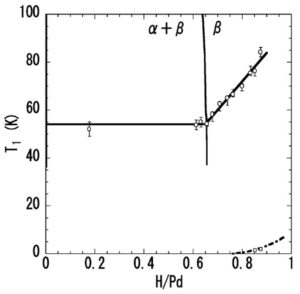
Figure 5. (Left) The Pd-H Phase Diagram with the phase sequence rule violated. This diagram is a metastable diagram lacking equilibrium phases (γ,δ, and δ’). adapted after Fukai [36].
Figure 6. (Right) A portion of the Pd-H Phase Diagram of Arakai et al [42] with the phase sequence rule violated. Open circles and open squares are from measurements in their work. This diagram is a metastable diagram lacking equilibrium phases (γ, δ, and δ’). after Araka et al. [42].
Figure 7. A portion of the Pd-H Phase Diagram of Arakai et al [38] [38 is Shackelford. Arakai is 42. One or the other is an error.] with red lines being another interpretation of phase boundaries. Open circles and open squares are from measurements in [their] work. This diagram is also a metastable diagram lacking equilibrium phases (δ, and δ’). adapted after Arakai et al. [42].
Figure 8 shows the unit cell for γ phase (Pd7VacD6-8) from Fukada et al. [22]. Delineation is revealed from two “unit FCC cells” (dark outline). From these, one sees the apposite true unit cell and superlattice structure of Pd7VacD6-8. D shifts slightly toward the corners allowing them to “bind” more to each vacancy. This is true for all of the D except the one in the central octahedral site, not bound or “trapped” to any particular vacancy. Depending if this site is occupied, stoichiometric ratio of D to Pd is between 6 to 8 for 7 Pd atoms, giving D/Pd ratio between .857 to 1.143: γ phase has mid-point stoichiometry D/Pd = 1 (subscript for D = 7).
Figure 8. Superlattice structure of Pd7VacD6-8. Left: super-cell lattice showing only vacancies. Right: half-cell structure magnified from the super-cell with heavy lines. The H-atom at the body center does not bind to any vacancy, thus the subscript for hydrogen varies within a range from 6 to 8. adapted from Fukada et al. [22].
Figure 9 combines the metastable diagram with SAV data to yield an equilibrium phase diagram. It has δ phase, Pd3VacD4, with D/Pd ratio 1.333 determined (see Appendix C) from XRD [15, 16, 17, 19, 20, 28, 30, 33, 35] since there are 4 D for every 3 Pd at strict stoichiometry. These two phases (γ and δ) must, by the sequence rule, be separated by a two-phase field of (γ + δ). The size of each phase field is determined as follows. The temperature extent has some uncertainty (dotted). The width of γ is based on the central interstitial site filling: empty in both half cells, filled in one of the two, or filled in both. For off-stoichiometry, the width of δ, from this analysis, is 1.333 +/- the same width as the two-phase fields on either side of γ (.095 from Figure 9). This gives D/Pd Min = 1.33 -.095 = 1.24 and D/Pd Max = 1.33 +.095 = 1.43. This construction follows Arakai’s et al [38] data, indicating start and end of the two-phase region (β + γ) at .76 and .85 respectively. It is suggested that the two-phase region on the right of γ has the same width (.095) from symmetry and a lack of data to support another value. This layout is qualitatively consistent with Fukai and Sugimoto [30, 31] who specify two phases of different vacancy concentrations (named here γ and δ) and dos Santos et al [20] who also show XRD evidence of two concentrations (12 % and 20%). In the XRD work of Fukada et al [22], these two phases were labeled “moderate” (.86 to 1.14) and “rich” (1.24 to 1.43) vacancy concentrations.
Figure 9. Equilibrium Phase Diagram for Isotopic Hydrogen – Palladium.
There is also a δ’ field, at D/Pd = 1.333 (Figure 9). The difference between δ and δ’ is D occupies octahedral sites in δ, while D occupies tetrahedral sites in δ’. The δ’ appears below a temperature of 375oK based on resistivity data (Discussion, section 5), and is supported by tetrahedral occupancy by D from Pitt and Gray [23] and Ferguson et al [24]. From DTF, Isaeva et al [29] found, at lower temperatures, tetrahedral site occupancy by H (D) stabilizes SAV more than octahedral site occupancy. Neutron diffraction data of Ferguson et al [24] and Pitt and Gray [23] show H migrates from octahedral to tetrahedral sites at lower temperatures.
The δ and δ’ phases are of interest to LENR. The δ” phase has been in superconductivity literature and will not be detailed other than noting existence and approximate position on the phase diagram. In addition, ε is not speculated on here other than its link to superconductivity at D/Pd ratio of 1.6 as Tripodi et al [43] have predicted. In summary, SAV phases (γ, δ, and δ’) are equilibrium phases, require creation and mobilization of vacancies, and are incorporated into the Pd-isotopic hydrogen equilibrium phase diagram.
3. Materials and experimental procedure
[redacted . . .]
Another important observation was change in resistivity during excess heat in Figure 24. Resistivity is
measured as a drop in voltage along the Pd with constant current. Each number on the time scale is 12 minutes (data taken every 15 minutes). From approximately 90 to 172 units on time scale, there is an irregular periodic drop in resistivity, interrupted only by a slight diffidence that vanishes quickly, followed by resumed drop.
Resistivity of PdD had gone over the hump (near D/Pd = .73) at the beginning of the run. This assured the
specimen was above the range of average D/Pd = .93 for the events featured here and all events of excess power and heat. What makes this drop particularly significant is the fact that temperature of the cell is increasing all the time resistivity is changing. This is shown in Figure 25 along with the temperature increase of the cell during resistivity drop. These events could be triggered by a sudden increase in current density, but they also happened, most often, spontaneously at constant current density.
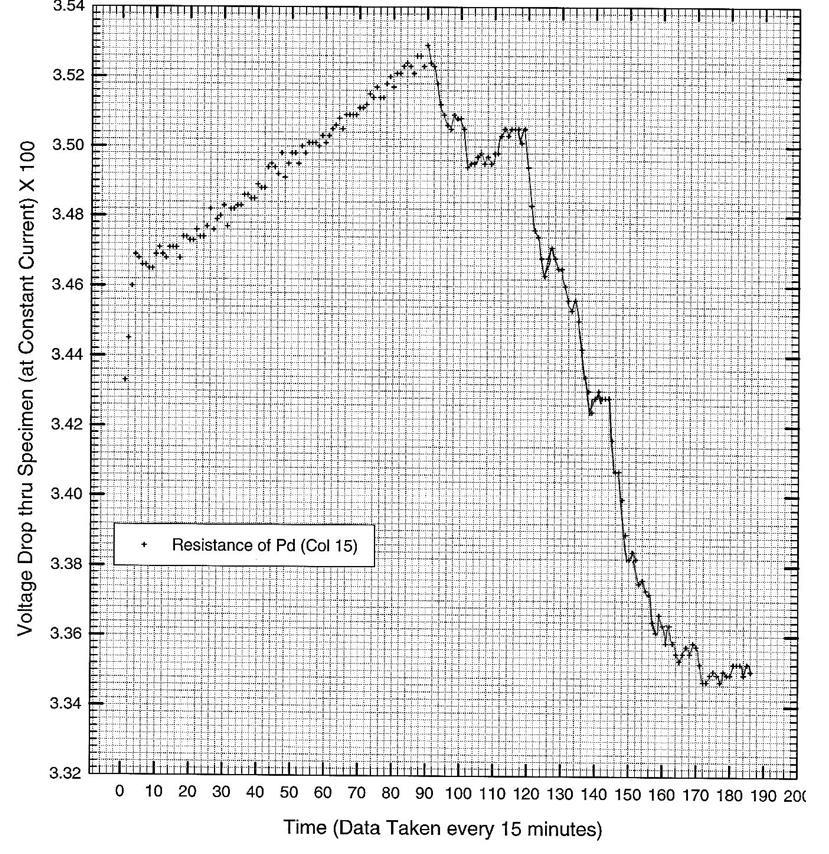 Figure 24. Left cell (Pd/Pt) in D2O exhibiting excess power ( + ). The resistivity of the PdD had gone over the hump in resistance (near D/Pd = .73) at the beginning of the run assuring specimen is in the range above an average D/Pd = .93 for the events featured here. The drop in voltage along specimen is from a change in its resistivity since electromigration current is constant and the temperature of the cell is increasing.
Figure 24. Left cell (Pd/Pt) in D2O exhibiting excess power ( + ). The resistivity of the PdD had gone over the hump in resistance (near D/Pd = .73) at the beginning of the run assuring specimen is in the range above an average D/Pd = .93 for the events featured here. The drop in voltage along specimen is from a change in its resistivity since electromigration current is constant and the temperature of the cell is increasing.
Figure 25. Left cell (Pd/Pt) in D2O exhibiting excess power with the specimen above an average D/Pd = .93. The drop in voltage is from a change in resistivity since electromigration current is constant and the temperature of the cell is increasing and electrolysis current density is constant.
5. Discussion
The magnitude of excess heat (Figures 22 and 23) confirms Fleischmann-Pons heat effect from nuclear origin. The amount of excess heat per cc of Pd (150 MJ/cc) or per Pd atom (14000 eV/atom) is too large for a chemical reaction, which produces energy per atom less than 2 eV/atom.
The drop in resistivity while temperature increases, is not expected behavior of PdD. Most metals and metal hydrides (or deuterides) show increasing resistivity with temperature [51, 52, 53], as in Figure 26. Nucleation of a new phase, other than beta (β) or gamma (γ), with lower resistance is likely occurring in Figures 24 and 25. If excess heat is from δ (Pd3VacD4 with D in octahedral sites), then formation of δ’ (Pd3VacD4 with D in tetrahedral sites), (Figure 27) enables extensive pathways of low resistance for electron transport along tubes, which are “vacancy channels” free of atoms along edges of unit cells. These extend from one unit cell to the next and intersect at all unit cell corners, as shown in Figure 28. The solubility of D(H) decreases with increasing temperature in Pd – H [54, 55, 56] and decreases in Pd-Ag alloys, as shown by Paolone et al [57]: they are exothermic [54]. With current density constant, fugacity is constant. Phase change to tetrahedral site occupancy is a change with more order as Isaeva et al [29] indicate: tetrahedral site occupancy is favored as a more ordered phase. Resistivity, in general, is larger in a disordered state than in an ordered state, as pointed out by Fukai [58]. Therefore the specimen is unlikely to be further loading itself with D (to lower resistivity), but rather more likely to be undergoing phase change from δ to δ’.
 Figure 26. Resistivity versus Temperature for Pd-H samples from low temperature to room temperature and extrapolated to temperatures above room temperature with a positive coefficient of resistivity. from Schindler et al. [51] and Tripodi et al. [52].
Figure 26. Resistivity versus Temperature for Pd-H samples from low temperature to room temperature and extrapolated to temperatures above room temperature with a positive coefficient of resistivity. from Schindler et al. [51] and Tripodi et al. [52].
Figure 27. The ordered unit cells of the delta (δ), Pd3VacD4 and delta prime (δ’), Pd3VacD4 phases. The main difference is that D occupies octahedral sites in δ and tetrahedral sites in δ’. Edges of the unit cell in δ’ are straight paths of open tunnels (or tubes) because of vacant Pd atoms. In δ, the only atoms in these tubes are D+ ions.
Sites for nucleation of δ’ would be less than the total volume fraction fv of δ phase in the cathode. This fraction is the active atoms divided by total atoms, determined as follows. The number of Pd atoms in specimens here is = 3.4 x 1020 atoms (size of Pd, Materials and experimental procedure section), while nuclear reactions could produces 23,800,000 eV per reaction. The actual energy produced is 14000 eV/Pd atom or 7000 eV/(D atom pair) over 46 days. Thus fv = 7000/23800000 = .0003 = .03%. The total number of D pairs participating = 1.0 x 1017 pairs out of 3.4 x 1020 atoms. If all of the δ phase is active in giving heat, then fv is too small to detect δ phase from metallurgical microscopy. The δ’ phase is an even smaller fraction, yet it produces a macroscopic effect (measureable lowering of overall resistivity of the bulk specimen). This implies the inherent resistivity of δ’ is very low (possibly even zero) since the total resistance of the cathode must obey the law of mixtures, combining resistivity of δ’ times its small volume fraction with resistivity of beta β times its volume fraction (complement fraction). Thus there is significant variation in resistivity from location to location within the bulk. This is consistent with observed local hot spots for production of tritium observed by Wills et al. [59] and Srinivasan et al. [60]. It is also consistent with small and scarce local explosive reactions in the lattice in near-surface region from volcanic-like eruptions observed in optical and scanning electron microscopy of the surface after excess heat [61].
Figure 29. Tubes for each unit cells of either δ or δ’ phases. These phases form a 3-D vacancy tube lattice or network of intersecting tunnels. The tube lattice (green) has Pd and isotopic hydrogen in the space between tubes in δ‘ (left image = Pd3VacD4 – T), or has only Pd atoms (right image = Pd3VacD4 – O) in the space with D+ inside the tubes in δ. Unit cell images (blue and red) after Isaeva et al [29].
The tube lattice (Figure 29) has Pd atoms nested between tube intersections: either Pd with D(H) or only Pd, depending on whether the phase is δ’ or δ (with D still inside the tubes). If D is still inside tubes (δ) as an ion, then this is a variant of Storms’ model [62]: an electron in between each D+ ion (Figure 30). Storms’ model might be improved by replacing a two-dimensional crack with a one-dimensional tube of diameter equal to about 1 Pd atom. The tube would maintain alignment and avoid the buckling problem inherent in two-dimensional crack space. Electron shielding, in two-dimensions, needs to be kept aligned to avoid instability (D(H) ion and electron pop sideways). The tube would keep the shielding aligned and avoid elastic buckling instability as in axially loaded beams in compression, Euler Buckling. In addition real metal cracks may be too wide (not sharp) on an atomic scale to align a string of alternating charges of ions as proposed by Storms [62]. The size and geometry of real cracks are shown in Figure 31 adapted from Liu et al [63] who used high resolution transmission electron microscopy HRTEM to document images at tips of cracks in silver Ag, a low stacking fault metal. Pd is a higher staking fault metal (approximately 10 times higher).
 Figure 30. Storms [62] has modeled electron shielding in a two-dimensional crack shown on left and available online: https://www.youtube.com/watch?v=SNodilc6su0 . The center shows that a string of alternating electrons and deuterons (protons) will buckle when left in a two-dimension crack with a third dimension of width of 1 atom. The present view of SAV in Figures 27 and 28 corrects the buckling problem since the lattice tube is 1 atom in diameter and maintains alignment when compressed axially.
Figure 30. Storms [62] has modeled electron shielding in a two-dimensional crack shown on left and available online: https://www.youtube.com/watch?v=SNodilc6su0 . The center shows that a string of alternating electrons and deuterons (protons) will buckle when left in a two-dimension crack with a third dimension of width of 1 atom. The present view of SAV in Figures 27 and 28 corrects the buckling problem since the lattice tube is 1 atom in diameter and maintains alignment when compressed axially.
Figure 31. High resolution transmission electron microscopy, HRTEM, images in silver Ag, a low stacking fault metal: (a) to (c) in situ HRTEM images during the crack propagation in the matric. (d) to (f) in situ HRTEM images during the penetration of the crack across the CTBs. The beam direction is parallel to <110>. The CTBs are outlined in red lines and the corresponding twin thickness is labeled in the unit layers. A stacking faults marked as SF_R is chosen as the reference. The crack surface changes from {100} to {110} after the crack penetration across the CTBs. P1, P2, P3 and P4 in (b) indicate slip planes. Crack is too large to support an aligned string of alternating deuterons and electrons. adapted from Liu et al. [63].
6. Summary and conclusions
(Redacted)
(3) The emended Palladium – Isotopic Hydrogen phase diagram is presented: Three new phases, from X-ray diffraction results from recent literature, are shown on the phase diagram as superabundant vacancies (SAV) phases and are: γ phase (Pd7VacD6-8), δ phase (Pd3VacD4 – octahedral), δ’ phase (Pd3VacD4 – tetrahedral). These phases are the lowest free energy phases at their respective compositions.
(4) Resistivity of Pd was used to assay D activity in the Pd lattice (ratio of D/Pd) and employed as an indicator of phase changes. The excess heat supports portions of the cathode being in the ordered δ phase (Pd3VacD4 – octahedral), while the drop in resistance of the Pd cathode during increasing temperature and excess heat indicates portions of the cathode transformed to the ordered δ’ phase (Pd3VacD4 – tetrahedral).
(5) The structure of δ phase (Pd3VacD4 – octahedral) and δ’ phase (Pd3VacD4 – tetrahedral) show a network or lattice arrangement of empty tubes (δ’) or tubes filled with isotopic hydrogen (δ). These empty tubes provide extensive pathways of ultra-high mobility of hydrogen (δ) or electrons (δ’) or both. It is proposed these tubes provide a pre-condition of nuclear activity.
(6) A model of electromigration is presented where these phases were encouraged by electromigration current, causing D+ ions (trapped to vacancies) to pull vacancies along and aid the formation SAV phases. The model of electromigration indicates considerable enhancement of D+ ions (higher D/Pd) at one end of the specimen raising the likelihood of SAV phases and nuclear activity.
(7) A plastic deformation based model offers a mechanism for vacancy production in the bulk lattice. Vacancies are created by dragging of jogs connected between screw dislocations. Jogs are created by intersecting dislocations. The creation and mobilization of these vacancies raise the likelihood of SAV phases and nuclear activity by mitigating the necessity for bulk diffusion from the surface or grain boundaries. It shows the importance of plastic deformation (by cold work or by a loading/unloading/reloading sequence) in preparing Pd (or Ni) specimens for LENR
8. References
[Links have been added to the Abstracts page. As well, open copies are shown there where they have been found.]
[1] Ian M. Robertson, P. Sofronis, A. Nagao, M.L. Martin, S. Wang, D.W. Gross, And K.E. Nygren, “Hydrogen embrittlement understood – 2014 Edward DeMille Campbell Memorial Lecture”, ASM International, Metallurgical and Materials Transactions B, (28 March 2015) DOI: 10.1007/s11663-015-0325-y Review of H Embrittlement Robertson2015
[2] A.K. Eriksson, A. Liebig, S.́ Olafsson, B. Hj̈orvarsson, “Resistivity changes in Cr/V(0 0 1) superlattices during hydrogen absorption”, J. Alloys Compd. 446–447 (2007) 526-529. Eriksson2007
[3] M. Khalid and P. Esquinazi, “Hydrogen-induced ferromagnetism in ZnO single crystals investigated by magnetotransport”, Phys. Rev. B 85, 134424 – Published 13 April 2012. Khalid2011
[4] D. E. Azofeifa, N. Clark, W. E. Vargas, H. Solís, G. K. Pálsson, and B. Hjörvarsson, “Temperature- and hydrogen-induced changes in the optical properties of Pd capped V thin films”, Physica Scripta, Volume 86, Number 6, Published 15 November (2012). Azofeifa2012
[5] S. Kala and B. R. Mehta, “Hydrogen-induced electrical and optical switching in Pd capped Pr nanoparticle layers”, Bull. Mater. Sci., Indian Academy of Sciences, Vol. 31, No. 3, June 2008, pp. 225–231. Kala2011
[6] H. Noh, Ted B. Flanagan, B. Cerundolo, and A. Craft, “H-Induced atom mobility in Palladium-Rhodium alloys”, Scripta Met. et Mat., Vol. 25 (1991) 225-230. Noh1991
[7] H. Noh, Ted B. Flanagan, M.H. Ransick, “An Illustration of phase diagram determination using H-induced lattice mobility”, Scripta Met. et Ma., Vol. 26 (1992) 353-358. Noh1992
[8] K. Baba, Y. Niki, Y. Sakamoto, A. P. Craft. Ted B. Flanagan, “The Transition of the hydrogen-induced LI2 ordered structure of Pd3Mn to the Ag3Mg structure”, J. Mats. Sci. Letters, November 1988, Vol. 7 Issue 11, pp 1160-1162 Baba1988
[9] R. Balasubramaniam, “Mechanism of hydrogen induced ordering in Pd3Mn”, Scripta Met. et Mat., Vol. 30, No. 7 (1994) 875-880. Balasubramaniam1994
[10] Scott Richmond, Joseph Anderson, and Jeff Abes, “Evidence for hydrogen induced vacancies in Plutonium metal”, Plutonium Futures — The Science Keystone, CO, September 19-23, (2010) 206 Richmond2010
[11] M. Wen, L. Zhang, B. An, S. Fukuyama, and K. Yokogawa, “Hydrogen-enhanced dislocation activity and vacancy formation during nanoindentation of nickel”, Phys. Rev. B 80, 094113 – (Published 28 September 2009).. Wen2009
[12] Y. Fukai, N. Okuma, “Evidence of copious vacancy formation in Ni and Pd under a high hydrogen pressure,” Jpn. J. Appl. Phys, 32, 1256 (1993). Fukai1993
[13] W. A. Oates and H. Wenzl, “On the Copious Formation of Vacancies in Metals”, Scripta Met. et Mat., Vol. 30, No. 7 (1994) 851-854. Oates1994
[14] W. A. Oates and H. Wenzl, “On the formation and ordering of superabundant vacancies in Palladium due to hydrogen absorption”, Scripta Met. et Mat., Vol. 33, No. 2 (1995) 185-193. Oates1995
[15] Y. Fukai, “The Metal–Hydrogen system: basic bulk properties”, 2nd ed., Springer, Berlin, Germany (2005) p. 216. Fukai2005
[16] Y. Fukai, “Superabundant vacancies formed in metal-hydrogen alloys”, Physica Scripta, Vol. 2003 No. T103 (2002) 11. Fukai2003c
[This was accepted in 2002 but not published until 2003. The recommended citation is “Y Fukai 2003 Phys. Scr. 2003 11″]
[17] Y. Fukai, “Formation of superabundant vacancies in M-H alloys and some of its consequences: a review”, J. Alloys Compd. 356-357 (3) (2003) 263-269. Fukai2003a
[18] D. Tanguy and M. Mareschal, “Superabundant vacancies in a metal-hydrogen system: Monte Carlo simulations”, Physical Review B 72, Issue 17 (2005) 174116. Tanguy2005
[19] Y. Fukai, “Hydrogen-Induced superabundant vacancies in metals: implication for electrodeposition”, ed. A. Ochsner, G. E. Murch and J. M. O\Q. Delgado, Defect and Diffusion Form, Vol. 312-315 (2011) pp. 1106-1115. Fukai2011
[20] D. S. dos Santos, S. Miraglia, D. Fruchart, “ A High pressure investigation of Pd and the Pd-H system”, J. Alloys Compd. 291 (1999) L1-L5. dosSantos1999
[21] Y. Fukai and N. Okuma, “Formation of superabundant vacancies in Pd hydride under high hydrogen pressures”, Physical Review Letters, 73, No. 12 (1994) 1640-1643. Fukai1994
[22] Y. Fukada, T. Hioki, and T. Motohiro, “Multiple phase separation of super-abundant-vacancies in Pd hydrides by all solid-state electrolysis in moderate temperatures around 300 C”, J. Alloys Compd. 688 (2016) 404e412. Fukada2016
[23] M. P. Pitt and E. MacA. Gray, “Tetrahedral occupancy in the Pd-D system observed by in situ neutron powder diffraction”, Europhys. Lett., 64 (3), pp. 344–350 (2003). Pitt2003
[24] G. A. Ferguson, Jr., A. I. Schindler, T. Tanaka, and T. Morita, “Neutron diffraction study of temperature-dependent properties of Palladium containing absorbed hydrogen”, Phys. Rev, 137 (2A) (1965) 483. Ferguson1965
[25] N. Eliaz, D. Eliezer, D. L. Olson, “Hydrogen-assisted processing of materials”, Mat. Sc. and Engr. A289 (2000) 41-53. Eliaz2000
[26] C. Zhang and Ali Alavi, “First-Principles study of superabundant vacancy formation in metal hydrides”, J. American Chem. Soc., 127 (2005) 9808-9817. Zhang2005
[27] Y. Fukai, M. Mizutani, S. Yokota, M. Kanazawa, Y. Miura, T. Watanabe, “Superabundant vacancy–hydrogen clusters in electrodeposited Ni and Cu”, J. Alloys Compd. 356-357 (2003) 270. Fukai2003b
[28] Y. Fukai, “Formation of superabundant vacancies in M–H alloys and some of its consequences: a review”, J. Alloys Compd. 356-357 (2003) 263. Fukai2003a
[29] L. E. Isaeva, D. I. Bazhanov, Eyvas Isaev, S. V. Eremeev, S. E. Kulkova and Igor Abrikosov, “Dynamic stability of Palladium hydride: An ab initio study”, International J. of Hydrogen Energy, (36), 1, (2011) 1254-1258. Isaeva2011
[30] Y. Fukai, H. Sugimoto, “Formation mechanism of defect metal hydrides containing superabundant vacancies”, J. Phys. Condens. Matter. 19 (2007) 436201 Fukai2007a
[31] H. Sugimoto, Y. Fukai, “Migration mechanism in defect metal hydrides containing superabundant vacancies”, Diffusion-fundamentals.org 11 (2009) 102, pp 1-2 Sugimoto2009
[32.] L. Bukonte, T. Ahlgren, and K. Heinola, “Thermodynamics of impurity-enhanced vacancy formation in metals”, J. Appl. Phys. 121, (2017) pp. 045102-1 to -11. https://doi.org/10.1063/1.4974530. Bukonte2017
[33] Y. Fukai, H. Sugimoto, “The Defect structure with superabundant vacancies to be formed from FCC binary metal hydrides: Experiments and simulations”, J. Alloys Compd. 446 & 447 (2007) 474-478. Reference error, this paper is Harada2007.
[34] R. Nazarov, T. Hickel, J. Neugebauer, “Ab Initio study of H-vacancy interactions in FCC metals: implications for the formation of superabundant vacancies”, Phys. Rev. B 89 (2014) 144108. Nazarov2014
[35] Y. Fukai, Y. Kurokawa, H. Hiraoka, “Superabundant vacancy formation and its consequences in metal hydrogen alloys”, J. Jpn. Inst. Met. 61 (1997) 663e670 (in Japanese). Fukai1997
[36] Y. Fukai, “The Metal–Hydrogen system: basic bulk properties”, 2nd ed., Springer, Berlin, Germany (2005) p. 10. Fukai2005
[37] H. Okamoto and T. Massalski, “Improbable phase diagrams”, J. Phase Equilibria, 12, No.2 (1991) p148-168. Title incomplete, it is “Thermodynamically Improbable Phase Diagrams.” Okamoto1991
[38] J. F. Shackelford, “Introduction to matr. sci. for engrs.”, 7th ed. Pearson, Upper Saddle River, NJ, pp. 272-3. Shackelford2009
[39] Tom Callahan and Fiona O’Connell, “Studies in EG459: special topics in materials engineering – steel metallurgy”, Loyola University Maryland, Fall (2011).
[40] Metals Handbook, Vol. 9 Metallography and Microstructures, 9th ed., American Society for Metals, Metals Parks, OH (1985) p.245. ASM1985
[41] M. R. Staker, “The Uranium – Vanadium equilibrium phase diagram”, J. Alloys Compd. 266 (1998) 167-179. Staker1998
[42] H. Arakai [sic, Araki], M. Nakamura, S. Harada, T. Obata, N. Mikhin, V. Syvokon and M. Kubota, “Phase diagram of hydrogen Palladium”, J. of Low Temperature Physics, Vol. 134, Nos. 5/6, (March 2004) pp. 145-1151. Araki2004
[43] Paolo Tripodi, Daniele Di Gioacchino, and Jenny Darja Vinko, “Magnetic and transport properties of PdH: intriguing superconductive observations”, Brazilian Journal of Physics, vol. 34, no. 3B, September, 2004. Tripodi2004
[References 44-50 redacted.]
[51] A. I. Schindler, R. J. Smith and E. W. Kammer, “Low–temperature dependence of the electrical resistivity and thermoelectric power of Palladium and Palladium-Nickel alloys containing absorbed hydrogen,” Proceedings of the International Congress of Refrigeration, Copenhagen, August 19-26, 1959, 10th Congress, Vol. 1, p. 74, Pergamon Press, Inc., New York, 1960. Schindler1960
[52] P. Tripodi, M. C. H. McKubre, F. L. Tanzella, P. A. Honnor, D. Di Giacchino, F. Celani, V. Violante, “Temperature coefficient of resistivity at compositions approaching PdH”, Physics Letters A 276 (2000) 122-126. Tripodi2000
[53] S. L. Ames and A. D. McQuillan, “The resistivity-temperature-concentration relationship in β-phase titanium-hydrogen alloys”, Acta Met. 4 (1956) 609. Ames1956
[54] W. Mueller, J Blackledge and G. Libowitz (ed), “Metal Hydrides”, Academic Press, N. Y. (1968) pp. 69 and 82. Mueller1968
[55] F. A Lewis, “The Palladium hydrogen system”, Academic Press, London (1967) pp. 7, 9, 22 and 119. Lewis1967
[56] R. A. Oriani, “The physical and metallurgical aspects of hydrogen in metals”, 4th International conference on cold fusion (ICCF-4), Lahaina, Maui, HI: Electric Power Research Institute, Palo Alto, CA (1993). Oriani1993
[57] A. Paolone, S. Tosti, A. Santucci, O. Palumbo and F. Trequattrini, “Hydrogen and deuterium solubility in commercial Pd–Ag alloys for hydrogen purification”, Chem. Engr. 1 (2017), 14; pp.1-9 doi: 10.3390/chemengineering1020014 MDPI, Basel, Switzerland. Paolone2017
[58] Y. Fukai, “The Metal hydrogen system – basic bulk properties”, 2nd Ed. Springer Berlin Heidelberg, New York, (2005) p43. Fukai2005a
[59] F. G. Will, K. Cedzynska, M. C. Yang, J. R. Peterson, H. E. Bergeson, S. C. Barrowes, W. J. West and D. C. Linton, “Studies of electrolytic and gas phase loading of Pd with deuterium”, in Conference Proceedings of Italian Physical Society, Vol. 33 for ‘The Science of cold fusion – Proc. of second Annual conf. on cold fusion’, edited T. Bressani, E. Del Giudice, and G. Preparata, Como, Italy, 29 June – 4 July 1991, held at A. Volta Center for Sci. Culture, Villa Olmo, (1991) pp. 373-383. Will1991
[60] M. Srinivasan, A. Shyam, T. C. Kaushik, R. K. Rout, L. V. Kulkarni, M. S. Krishnan, S. K. Malhotra, V. G. Nagvenkar, and P. K. Iyengar, “Observation of tritium in gas/plasma loaded titanium samples”, “AIP Conference proceedings 228 – Anomalous nuclear effects in deuterium/solid system”. 1990. Brigham Young Univ., Provo, UT: American Institute of Physics, New York, p 514-534. Srinivasan1990
[61] David J. Nagel, “Characteristics and energetics of craters in LENR experimental materials”, J. Condensed Matter Nucl. Sci. 10 (2013) 1–1. Nagel2013
[62] Edmund Storms, “An Explanation of low energy nuclear reactions (cold fusion)”, https://www.youtube.com/watch?v=SNodilc6su0, accessed May 15, 2018. Carat2012
[63] L. Liu, J. Wang, S. K. Gong & S. X. Mao, “Atomistic observation of a crack tip approaching coherent twin boundaries”, Scientific Reports vol. 4, Article number: 4397 (2014) doi:10.1038/srep04397. Liu2014


